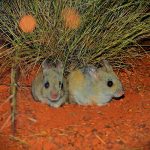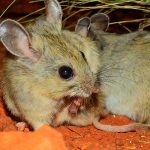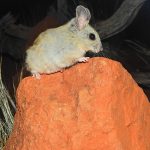PLAINS MOUSE
The Plains Mouse also known as Plains Rat and Palyoora, is native to the arid and semi-arid regions of Australia. It primarily inhabits the stony deserts and grasslands of South Australia, Northern Territory, and parts of Western Queensland.
These areas, characterised by sparse vegetation and harsh climatic conditions, provide a challenging yet suitable environment for the Plains Mouse.
It is highly adaptable to its harsh environment, capable of surviving with minimal water intake by deriving moisture from its food.
They create intricate burrow systems to escape the daytime heat and predators. These burrows also provide a microhabitat for other small creatures.
The Plains Mouse has a relatively short lifespan, typically living up to two years in the wild. This small rodent, with a body length of about 10-12 cm and a tail roughly the same length, is well-adapted to its environment. Its fur is generally grey-brown, providing excellent camouflage against the rocky and sandy terrain.
Breeding for the Plains Mouse is closely tied to the availability of food and favourable weather conditions. They tend to breed after periods of rainfall when food resources are abundant. Females can give birth to multiple litters each year, with each litter containing up to four young. The young are born blind and hairless but grow rapidly, becoming independent within a month.
The diet of the Plains Mouse is quite varied and opportunistic. They primarily feed on seeds, green vegetation, and insects. Their foraging behaviour is nocturnal, which helps them avoid the extreme daytime temperatures of their arid habitat. This diet not only sustains them but also plays a crucial role in the dispersal of seeds, contributing to the ecological balance of their environment.
For Aboriginal peoples, the Plains Mouse holds cultural significance. Indigenous Australians have long understood the intricate balance of their natural environment, and the Plains Mouse is part of this knowledge. It features in traditional stories and is considered an indicator of environmental health. The presence of these mice can signify good seasons and the availability of certain food resources.
Currently, the Plains Mouse is classified Endangered primarily due to habitat degradation caused by livestock grazing, invasive species, and climate change. Conservation efforts are focused on habitat restoration and controlling invasive species to ensure the survival of this unique rodent.
The story of the Plains Mouse is a reminder of the delicate balance within our ecosystems. By understanding and protecting such species, we contribute to the health of our planet. Each small creature, like the Plains Mouse, has a significant role in the grand tapestry of nature.



